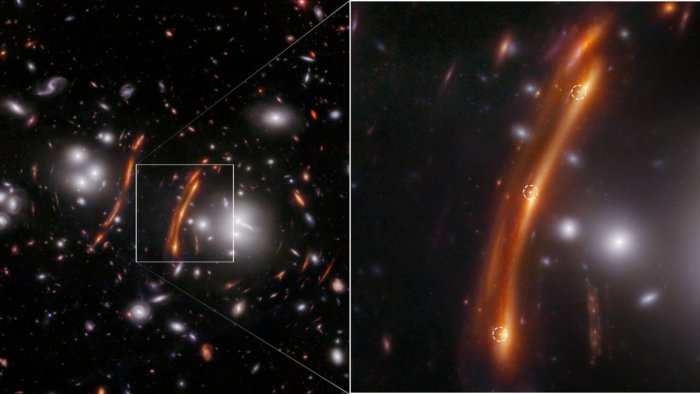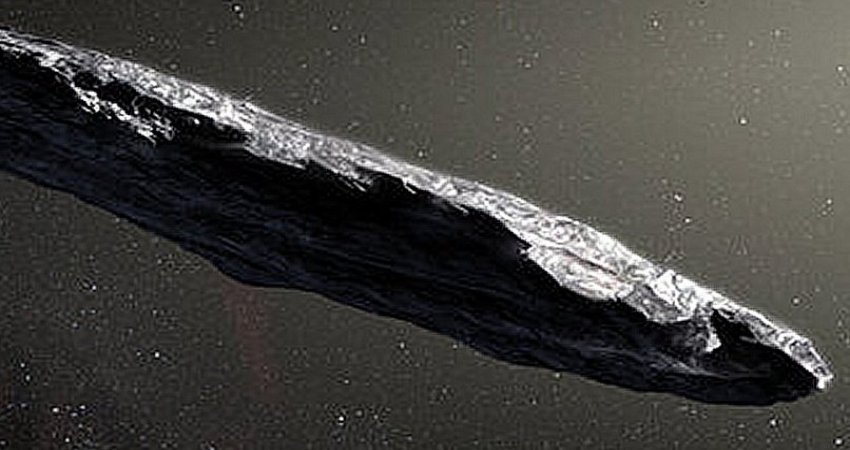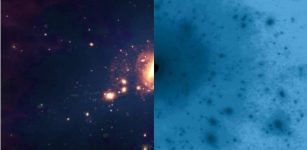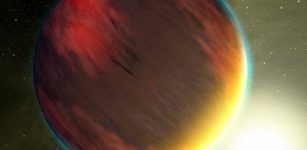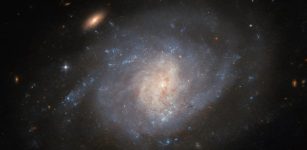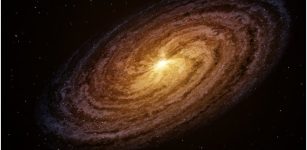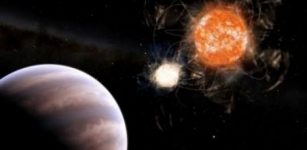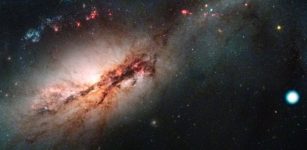Hubble Tension Through Lensed Supernova Discovery – Confirmed
Eddie Gonzales Jr. – MessageToEagle.com – For decades, space and ground-based observatories have provided astronomers worldwide with precise measurements of the Hubble constant (H0) — the rate at which the universe is expanding.
NASA’s James Webb Space Telescope’s NIRCam (Near-Infrared Camera) image of the galaxy cluster PLCK G165.7+67.0, also known as G165, on the left shows the magnifying effect a foreground cluster can have on the distant universe beyond. The foreground cluster is 3.6 billion light-years away from Earth. The zoomed region on the right shows supernova H0pe triply imaged (labeled with white dashed circles) due to gravitational lensing. Credit: NASA, ESA, CSA, STScI, B. Frye (University of Arizona), R. Windhorst (Arizona State University).
Now, with NASA’s James Webb Space Telescope and its powerful capabilities included in this lineup of observatories, astronomers are obtaining an even better understanding of the universe.
Earlier this year, astronomers used Webb observations of Cepheid variables and Type Ia supernovae, reliable distance markers to measure the universe’s expansion rate, to confirm NASA’s Hubble Space Telescope’s previous measurements.
Researchers are now using an independent measurement method to enhance the precision of the Hubble constant in the form of gravitationally lensed supernovae.
This is the subject of several recent studies by a team of many researchers from different institutions around the world, including Arizona State University researchers Seth Cohen, Nick Foo, Patrick Kamieneski and Rogier Windhorst, PEARLS principal investigator, all in the School of Earth and Space Exploration.
It all started with one question by the team: “What are those three dots that weren’t there before? Could that be a supernova?”
The points of light, not visible in 2015 Hubble imaging of the same cluster of galaxies, were obvious when the images of PLCK G165.7+67.0 arrived from Webb’s Guaranteed Time Observations of the Prime Extragalactic Areas for Reionization and Lensing Science (PEARLS) program.
The team notes that the question was the first to come to mind for good reason: The field of G165 was selected for these observations due to its high rate of star formation of more than 300 solar masses per year, an attribute that correlates with higher supernova rates.
Initial analyses confirmed that the observed dots corresponded to an exploding star, one with exceptional characteristics.
First, it was identified as a Type Ia supernova — an explosion of a white dwarf star at the end of its life. This type of supernova is often referred to as a “standard candle” due to its predictable intrinsic brightness. Second, the supernova was gravitationally lensed. The team named their discovery “SN H0pe.”
Gravitational lensing played a key role in this discovery. A galaxy cluster positioned between the supernova and Earth acted as a lens, bending the supernova’s light and splitting it into multiple images. Much like how a trifold mirror produces three different reflections of the same subject, the lensing effect created multiple images of the supernova. In the Webb image, this was vividly demonstrated by the middle image, which appeared flipped relative to the other two, a phenomenon predicted by gravitational lensing theory.
To produce three images, the light from the supernova traveled along three distinct paths. Because each path varied in length, and light moves at a constant speed, the supernova was captured at three different moments of its explosion in the Webb observation. Returning to the trifold mirror analogy, it’s as if there were a time delay: The right-hand mirror might show a person lifting a comb, while the left-hand mirror would show the hair being combed and the middle mirror would depict the comb being put down.
These “trifold” supernova images are particularly significant. The time delays between the images, combined with the supernova’s distance and the properties of gravitational lensing, provide crucial information to calculate the Hubble constant, or H0 (pronounced “H-naught”).
This constant helps astronomers refine their understanding of the universe’s expansion rate. Appropriately, the supernova was named SN H0pe, as it brings new hope for uncovering insights about the universe’s evolving expansion.
Discovering a rare event like this gravitationally lensed supernova requires a bit of luck, but it isn’t completely random. We can identify galaxies that are likely to have high rates of supernovae, either because they contain a very large number of stars or because they have recently formed many short-lived, massive stars,” Kamieneski, a postdoctoral fellow said.
“In fact, on the opposite side of the galaxy cluster, there is another gravitationally lensed object that looks quite similar to the one that hosted SN H0pe. It turns out that this is actually a pair of galaxies in close proximity that are interacting with each other through gravity.
“This intense, violent tango between these massive galaxies is driving the formation of new stars at a rate of hundreds of solar masses per year. This sets the stage for other supernovae to be discovered in the G165 field in the future, making it well worth keeping an eye on with the Webb telescope.”
Kamieneski’s findings were recently published in The Astrophysical Journal.
Seven subgroups contributed lens models describing the 2D matter distribution of the galaxy cluster. Each model was “graded” based on its ability to predict time delays and supernova brightness relative to the measured values, given that Type Ia supernovae are standard candles. In an effort to explore SN H0pe further, the PEARLS-Clusters team wrote a Webb Director’s Discretionary Time, or DDT, proposal that was evaluated by science experts in dual-anonymous review and recommended by the Webb Science Policies Group for DDT observations.
In parallel, data was acquired at the Multiple Mirror Telescope, a 6.5-meter telescope on Mount Hopkins, and the Large Binocular Telescope on Mount Graham, both in Arizona. In analyzing both observations, the team was able to confirm that SN H0pe is anchored to a background galaxy, well behind the cluster, that existed 3.5 billion years after the Big Bang.
“It was always within the realm of possibility to discover a supernova in this data, but to find this special type of supernova at this particular early phase of its evolution was extremely lucky, and allowed for all these investigations to be done in what is truly a team effort,” said Cohen, co-author on another paper recently published in The Astrophysical Journal.
SN H0pe is one of the most distant Type Ia supernovae observed to date. A different team member made another time delay measurement by analyzing the evolution of its light dispersed into its constituent colors or “spectrum” from Webb, confirming the Type Ia nature of SN H0pe.
To prevent biases, the results were blinded from these independent modeling groups and revealed to each other on the announced day and time of a “live unblinding.” The team reports the value for the Hubble constant as 75.4 kilometers per second per megaparsec, plus 8.1 or minus 5.5. (One parsec is equivalent to 3.26 light-years distance.)
This is only the second measurement of the Hubble constant by this method, and the first time using a standard candle.
“This is one of the great Webb discoveries, and is leading to a better understanding of this fundamental parameter of our universe,” Windhorst said.
“Our team’s results are impactful. The Hubble constant value matches other measurements in the local universe and is somewhat in tension with values obtained when the universe was young,” said PEARLS co-lead Brenda Frye with the University of Arizona. “Webb observations in Cycle 3 will improve on the uncertainties, allowing more sensitive constraints on H0.”
The data collected and research are part of an international collaboration of scientists who have worked together throughout the course of the year to publish a suite of journal papers with their findings here:
JWST Spectroscopy of SN H0pe: Classification and Time Delays of a Triply-imaged Type Ia Supernova at z = 1.78
JWST Photometric Time-Delay and Magnification Measurements for the Triply-Imaged Type Ia “Supernova H0pe” at z = 1.78
The JWST Discovery of the Triply-imaged Type Ia “Supernova H0pe” and Observations of the Galaxy Cluster PLCK G165.7+67.0′
Spectroscopy of the supernova H0pe host galaxy at redshift 1.78
Birds of a Feather: Resolving Stellar Mass Assembly With JWST/NIRCam in a Pair of Kindred z=2 Dusty Star-forming Galaxies Lensed by the PLCK G165.7+67.0 Cluster
Press release adapted from the Space Telescope Science Institute with contributions from ASU’s School of Earth and Space Exploration.
Written by Eddie Gonzales Jr. – MessageToEagle.com Staff Writer

